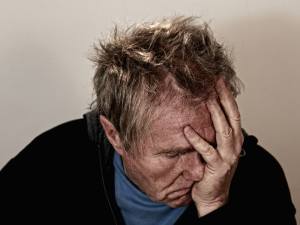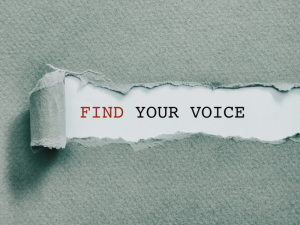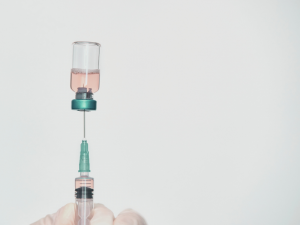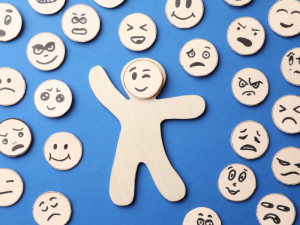If you’re in the U.K., it won’t have passed you by that the nights are drawing in (it seems a tad early to me); the shorter days remind me to welcome autumn, but I do so with mixed feelings. While I love the hues of the season and the prospect of wrapping up in cosy knits. I dread the clocks going back because I’m at risk of my mood dropping faster than the leaves of an Ash tree (it’s the first to lose its leaves). If you have ever felt the same, you may be at risk of seasonal-affected disorder (S.A.D.), aka winter depression.
Living in the northern hemisphere means the change of seasons can profoundly affect some people’s wellbeing, energy levels, and mood, for some simply craving carbohydrates or wanting to hibernate through the typically grey-skied U.K. winters. For others, winter brings on an annual disabling illness with a considerable impact that prevents them from functioning at their best or, in some cases, at all for months.
5 facts about S.A.D.
- It can affect anyone in the Northern Hemisphere, including children.
- S.A.D. is rare in those living within 30 degrees of the equator, where daylight hours are long, constant, and bright.
- It may be hereditary.
- S.A.D. can begin at any age, but typically, the onset is between 18 and 30 years.
- Doctors in the U.K., Europe, Australia, and Canada estimate that at least 5% of the population suffers from S.A.D., but it’s probably an underestimate.
This is the critical time to put steps in place to avoid or manage winter depression.
Causes and risk factors
The exact cause of S.A.D. needs to be better understood; however, it’s linked to reduced exposure to sunlight during the shorter autumn and winter days. Compared to the 19th century, 75% of the population worked outdoors. Less than 10% of people work in natural outdoor light or get access to enough daylight. The leading hypothesis is that a lack of sunlight reduces the efficient function of the hypothalamus gland in the brain, which affects:
- Melatonin levels. This is the hormone that makes us sleepy; one theory is that it may be produced at higher-than-typical levels in individuals susceptible to S.A.D.
- Serotonin. Lack of sunlight may lead to lower levels of this neurotransmitter, which also acts as a hormone affecting mood, appetite and sleep.
- The body’s circadian rhythm or internal clock uses sunlight to time various essential functions, such as when we wake up, so lower light levels during the winter may disrupt the body’s internal clock and lead to symptoms.
- The other consideration is low Vitamin D; sunlight helps produce vitamin D, which supports serotonin levels and mood. As there is less sun during UK winters, deficiency is more common.
- It’s also possible that some people may have increased vulnerability to seasonal affective disorder because of previous trauma, a stressful event such as childbirth, redundancy or bereavement, long-term illness or genetic factors.

My experience
I first experienced a mood drop during the winter after sustaining a traumatic head injury, which resulted in post-concussion syndrome, photophobia and amnesia. So following the medical advice to avoid brightly lit places, bright sunlight and wearing tinted glasses seemed sensible and avoided discomfort. This was long before I had any medical training, and I had many more significant problems to manage at the time and other reasons to be down, so when my mood seemed to dip during the winter, it was put down to the life-changing injuries and trauma I had sustained. However, over a few years, a pattern emerged: lethargic and low in winter, brighter and more contented the rest of the year.
Although S.A.D. was identified as a treatable clinical condition during the 1980s, it wasn’t considered a condition by most G.P.s at the time. I was fortunate to get a proper diagnosis and help while travelling in the U.S.A. Fortunately, with some pretty simple measures, I’d been free of S.A.D. for many years; I spent part of the winter in warmer, sunnier climes; my previous career and family in the tropics made this easy. Ahh, those were the winters, sitting under massive orchids-entangled mango trees enchanted by playfully feeding hummingbirds and baby lizards or early morning breakfasts on deserted beaches. It wasn’t all magical – mosquitoes and red ants are vicious, devious critters!

Out of nowhere, it returned last year. Well, that’s not strictly true; I didn’t take my usual preventive steps in September because I had loads of sun exposure, so I assumed the reservoir was full. Moreover, I completely missed the critical early signs, and it wasn’t until January that I took any meaningful action against the lethargy, low mood, and unrelenting desire for toasted sourdough, which meant it was really challenging to manage and didn’t resolve as quickly as previous episodes, which really knocked me. While it might have been a one-off ‘bad’ year, I am not taking any chances this year; vitamin D levels have been checked, and I’ve upgraded to a brighter lightbox, which I started using earlier this month. I am sharing this because if I can get caught out, anyone can, and perhaps my experience might help someone recognise the signs and symptoms in themselves, a family member or a friend and save themselves a miserable or difficult winter. Plus, we all need to do our bit to break the stigma around mental health disorders because no one is immune.
Signs and symptoms
While misunderstood, S.A.D. is a recognised mental health disorder; the essential distinguishing feature is that it’s seasonal, so symptoms disappear when the season changes. It affects people differently, and the symptoms may vary based on the type of S.A.D. Winter episodes seem to be more common, but some people experience symptoms during the summer.
Symptoms of winter S.A.D. include:
- A persistent low mood or irritability
- Daytime fatigue
- Loss of pleasure or interest in hobbies and pastimes
- Feelings of hopelessness, despair, guilt or worthlessness
- Difficulty concentrating and memory problems
- Increased sensitivity to criticism or rejection
- Lethargy (lacking in energy)
- Social withdrawal/lack of interest in social activities
- Disturbed sleep and early morning awakening.
- Sleeping for longer than usual and finding it hard to get up in the morning
- Needing a nap in the afternoon
- Change in appetite, such as craving carbohydrates
- Weight gain
- Anxiety, tension, or stress that are harder to manage
- Decreased libido, reduced sexual interest
- Unexplained unhappiness
Symptoms of summer S.A.D. include:
- Agitation
- Difficulty sleeping
- Increased restlessness
- Lack of appetite and weight loss
Often a misunderstood illness, those affected by S.A.D. sometimes attribute their symptoms to stress or other lifestyle factors, such as spending more time indoors over the winter. Others believe it is because they are lazy or greedy, neither accurate nor helpful. One of the most important distinguishing features of S.A.D. is that it’s seasonal, and depending on the intensity of sunlight, onset and improvement can be sudden or gradual.
If this sounds familiar, your G.P. or allied mental health professional should be your first port of call; they should assess your physical and mental health, asking about your mood, lifestyle, eating habits, sleep patterns, plus any seasonal changes in your feelings, thoughts and behaviour. They may use a paper or online assessment tool with multiple-choice Q&A, which can be a helpful way of assessing the severity and longevity of your symptoms. Remember, while symptoms over two or more consecutive winters are needed to confirm a diagnosis of S.A.D., it doesn’t mean you shouldn’t seek advice earlier or treatment isn’t available.
Tip: Take a list of your symptoms and consider booking a double appointment so you have more time.
Treatments for S.A.D.
The National Institute for Health and Care Excellence (NICE) recommends that S.A.D. be treated the same way as other types of depression, including lifestyle measures, therapy/counselling, and medication. Crucially, the earlier you put them in place, the more likely you are to manage or halt your symptoms. Speak to your primary healthcare provider.
Self-help
Managing winter S.A.D. can be as simple as increasing light exposure; drinking your morning cuppa outside or by a window can help you feel less sluggish.
Lighting up your life.
- There is a lot of good research about viewing early morning sunlight and its importance to our wake-sleep rhythms, mood, metabolism, and general health and wellbeing. According to Prof Huberman and many others, it’s the single most effective practice except exercise for enhancing mental and physical health.
- Planning how you increase or supplement your daylight exposure from September is critical if you’ve experienced S.A.D. in the past.
- Try to get outside within an hour of rising to regulate your circadian rhythm. Depending on how grey the day is, opt for 30 – 60 daylight minutes. You don’t need to stare at the sun, and it shouldn’t hurt your eyes. Don’t wear sunglasses unless you have extremely sensitive eyes or have been advised to do so for health reasons.
- If that’s not possible and you wake up and struggle to feel alert, consider using a dawn-simulating alarm clock (see below). Then switch on as many bright lights as possible (being mindful of the environment and energy costs) and take a brief walk by lunchtime if your schedule permits.
- During the autumn and winter, make your work and home environments as light as possible during the day. Sitting near or facing windows indoors is especially important for those who have switched to working from home or hybrid working and may be tucked in a dark spare or attic room or switching to daylight lamps.
Lightboxes and light therapy
Light therapy involves using a special lamp that simulates the sunlight missing during the dark months. Lightboxes come in various designs, including desk and wall-mounted fixtures, visors and glasses. They produce a dazzling light measured in lux; the higher the lux, the brighter the light and the less treatment time needed. For example, treatment using 10,000 lux Lightboxes can take as little as 30 minutes a day. The recommendation is 30 to 60 minutes of light therapy every morning. Using it later in the day may cause sleep difficulties.
Approved medical lightboxes have filters that remove harmful ultraviolet (UV) rays. They are generally safe and well-tolerated, so that most people can use them without the risk of skin or eye damage. But they may not be suitable for everyone, so please check first with your GP, especially if you have diabetes and an optician if you have a retina or other eye conditions. Lightboxes aren’t available on the N.H.S. but are VAT-exempt for medical use.
The evidence is mixed regarding the overall effectiveness of light therapy; some studies have concluded it is helpful if used first thing in the morning. Others state they are best for short-term results, helping relieve symptoms when they occur. If light therapy is beneficial, most people notice an improvement in their symptoms within 7–14 days.

Light therapy explained
Light therapy encourages the brain to rebalance hormones affected by low light, reduces the level of melatonin and increases the production of serotonin to help regulate the sleep/wake cycle and mood.
Things to consider when using a lightbox:
- Never look directly into the light.
- Keep the box 6- 60 cm (16 to 24 in) away from your face.
- Follow the instructions carefully.
- Check with your doctor before using.
Note: Not all interventions work for everyone. If light therapy is going to help, most people notice a positive change after 7-14 days of daily use, and you need to keep going until the clock springs forward in March.
Dawn-stimulating alarm clocks may also help some people. They brighten the bedroom with gradual increases in light with a 30-minute sunrise timer, which helps to regulate the sleep/wake cycle. Fans report a boost in their mood, energy and productivity levels for the rest of the day.
Side note. Light therapy work, lightboxes and a dawn-stimulating alarm clock have been revolutionary for me in the past, especially when I’ve been unable to get away for a few weeks of winter sun; I pop a note in my calendar to light up my life on the first day of autumn. This is not medical advice.
Medication
Antidepressants can be helpful and are most effective if taken before the symptoms appear and continued until spring. Note: they take four to six weeks to take full effect, so if they helped in the past, you need to start soon.
Talking therapies
NICE) recommendations Cognitive Behavioural Therapy (CBT) or counselling. My preference would be to seek out a Human Given Psychotherapist; this is not medical advice.
Self-help to prevent or manage S.A.D.
Preventing the first episode of seasonal depression is impossible, and getting a confirmed diagnosis requires, in most cases, repeated episodes. There are simple steps to prevent or lessen symptoms. Plan: head and talk to your doctor or other healthcare providers about preventive treatment.
If you’ve been diagnosed with seasonal affective disorder, you can reduce the onset of symptoms and sometimes prevent it with early action.
- Monitor your mood and energy level.
- Talk to your doctor or other healthcare providers about preventive treatment.
- Take a walk outside early in the day
- Consider using a daylight alarm clock
- Start using a Lightbox from September before symptoms begin to ensure you get enough light throughout the day.
- Plan pleasurable activities during colder months
- Seek help sooner rather than later if you are struggling
Share; it’s good to talk
Tell family, friends and work colleagues if you have Seasonal Affective Disorder (S.A.D.) and how it affects YOU. They can offer better support if they understand how your wellbeing changes during the winter.
Final words
Self-help for S.A.D. can be as simple as increasing light exposure or drinking your morning cuppa outside or by a window to help you feel less lethargic. For those like me who’ve previously experienced seasonal low mood, it is best to start ‘treatment’ before symptoms reemerge. I pop a note in my calendar to light up my life on the first day of autumn.
Disclaimer
Please note: This information is for guidance only and should not be considered a substitute for medical advice, diagnosis or treatment given in person by a trained health professional.







